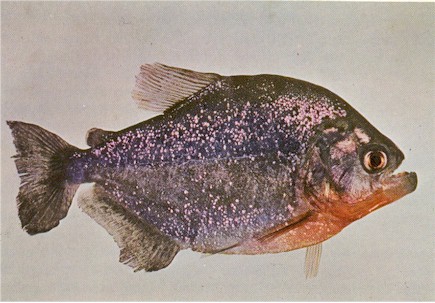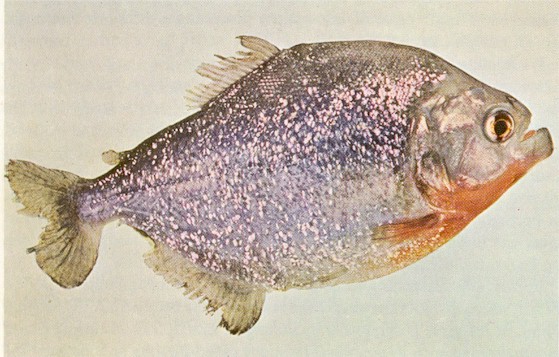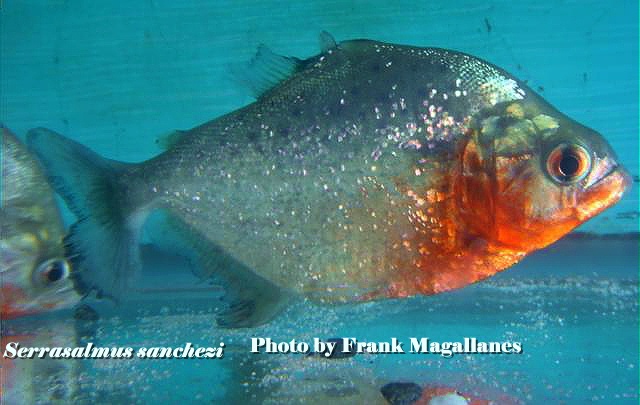First actual recorded spawning of S. spilopleura (S. maculatus), Braker and Ledecky
By Emanuel Ledecky, Cincinnati Aquarium, 1966
FROM FRANK MAGALLANES
It remains my opinion the species that spawned at the Cincinnati Aquarium was not S. spilopleura (S. maculatus) as reported but is in fact the species we call SPILO CF or S. sanchezi. The Hiroshe Azuma fish also reported to be S. gibbus, but also resembles the actual S. spilopleura (S. maculatus) was later revised by Michel Jégu as S. maculatus! So it begs the question what species are we really dealing with that was bred in the Shedd Aquarium? The young of this species as seen by the photos below and the adults all seem to fit the S. sanchezi description. The hyaline border common to S. spilopleura and S. maculatus is not present in the juvenile form. Indeed, the tail is similar to rhombeus group members which S. sanchezi is a member of. While this is an opinion only, it does not mean that I am correct in this assumption. Only that the fishes resemble S. sanchezi and not S. spilopleura.
October 4, 2006 - Since I first wrote this page in 2003, I have been able to secure a copy of the 1960 article by Dr. W. P. Braker. This allowed me to examine the photos that Ledecky had stated were S. spilopleura (S. maculatus). Ledecky also stated that the accompanying photos from the Shedd seemed to confirm the Braker identification on these fish at the Fleischman Aquarium. However, some questions have been raised as the authenticity of the Ledecky fishes as being the actual representatives on the fish in that aquarium that was published by Tropical Fish Hobbyist magazine. While Ledecky is not available to answer questions about the TFH photos, I have been in contact with Dr. Braker and is assisting me to piece this bit of history together.
October 22, 2006 - While Braker remains sure of his ID for the period 1960 that the fish was properly identified as S. spilopleura (and I agree with him, but with the exception Jegu has rehabilitated the species as S. maculatus), The enigma of Axelrod's photos in the Ledecky article (1966) follows the history of problems (egregious mistakes) with book and magazine publications and their use of piranha photos captioned improperly with scientific names.
We cannot go back in time to correct the issue why Axelrod substituted S. sanchezi photos for S. spilopleura, because during that time S. sanchezi was considered (erroneously) a member of the spilopleura complex forms (they are members of the rhombeus group). But the Axelrod photos (according to Braker) does not measure up to the fishes he bred in 1960. S. spilopleura has since been rehabilitated as S. maculatus. S. sanchezi (1964) was identified by me via photos in 2002 and properly placed as this species at OPEFE web pages.
I will forever more be grateful to Dr. William Braker for his input on this interesting, historical document.
Frank Magallanes, October 22, 2006
Spawning Piranhas by Emanuel Ledecky, Cincinnati Aquarium [Condensed version by Frank Magallanes, OPEFE, January 27, 2003].
A 300 gallon unlandscaped tank at the Fleischman Memorial
Aquarium housed 3 adult piranhas. These were a gift of the Shedd Aquarium and
were probably the result of an earlier successful spawning described by Bill
Braker. For reasons given in his article, Braker had identified them as Serrasalmus
spilopleura and the accompanying photographs matched the Cincinnati fish
exactly, but remains uncertain because many of this group, however, is very
confusing. 2 of the 3 fish were about 7 inches in total length, the 3rd about an
inch shorter. All fish showed heavy scar tissue and repeated damage and
regeneration. Their unpaired fins were almost non-existent. In an attempt to
give them greater security and improve the appearance of the tank, driftwood and
aquatic plants were added. Still some fin-nipping went on. I decided to add
other fishes to act as a distraction, but one does not simply add other fish to
a piranha tank. Up this point live fishes, mostly bluegills and goldfish, were
part of their diet and were quickly attacked and devoured. Guppies were totally
ignored, apparently too small and beneath the piranhas' notice. A large fire
mouth cichlid was then tried. One day a piranha met his his charge and bit off
this nose!
At the time I happened to have a surplus of Tilapia sparrmannii and tried these alert and cagey fish next. These did well and all survived. More valuable fish such as Exodon paradoxus and Cheirodon axelrodi were then added. The community thrived and the strategy worked to some extent. The piranhas still chewed each other occasionally, but their fins began to regenerate. Strips of beef heart became the main part of their diet. During the winter the water temperature fluctuated from 67 to 76 F. The fish occasionally chased each other and were observed to assume a tight head-to-tail position, circling as if attempting to bite each other tails. This behavior in itself is not unusual, as head-to-tail circling, tail slapping, and similar displays are seen in a number of different species, even among fish of the same sex or those too young to breed. I suspected more was happening. The color of all the piranhas deepened. Instead of silver, the body color became smoky gray and the fins almost black. The circling became more frequent; sometimes all three fish participated.
February 11, while making a check after the close of the aquarium, I noticed two piranhas, one smaller than the other, side by side in mid-water. Finding two piranhas so close together and not helping themselves to a piece of their neighbor is most unusual. As I watched, the fish slowly rose by beats of their pectoral fins. Just beneath some floating water sprite they tilted sharply upward, came close together, trembled, and parted. A cascade of eggs was falling through the water and was almost instantaneously devoured by the Exodon and the parents themselves. These eggs were scooped into a tray and I noticed little translucent globules on the roots of the floating water sprite. There they were in numbers, clustered like plums on a tree!
Methylene blue and an air stone was added to the tray and our hard water cut one-half with snow water. In 24 hours embryos could be seen moving in the eggs, and a day later they began to hatch. The young hung belly up in a horizontal position by a thread extending from their yolk sacs. They became quite active; by nine days after hatching, when almost half an inch long, all fry were free-swimming. From the beginning, brine shrimp were eaten and in only a few days young white worms were eagerly accepted.
I prepared the tank for another spawning by adding a large water hyacinth with long trailing roots and a piece of unwound rope. A month later to the day after the first spawning, on March 11, the piranhas again spawned. Both the water hyacinth and the rope were ignored, the eggs were again deposited on the roots of the water sprite, with some adhering to a piece of driftwood.
There appeared to be no guarding by the parents and the eggs were left undisturbed. A short time later all the eggs were gone. I was now fairly certain that the spawning pattern differed from previously published accounts. I was so certain I predicted the next spawning time and date. On April 10 the third spawning took place, again in the late afternoon. This part of my prediction proved true. I had, however, been too authorative with only limited experience. In this and other subsequent spawning the water hyacinth roots were used, and the fish prepared the site by chewing some of the rootlets off, forming sort of a hollow near the center.
Observation of many spawning runs did not clarify the sexes of the fish. Even though I placed my wife at another angle to the spawning pair and we both watched intently. Neither of us could tell which fish actually released the eggs. The motion, speed, and the close proximity of the vent areas made it impossible. The smaller fish was darker, more angular, and had less fin damage. During spawning its anal fin overlapped the vent of the larger fish in a manner similar to that of the male Metynnis. It was assumed, then, that the smaller fish was the male. Later spawning themselves differed from the one I first observed. The pair not only turned upward but sometimes continued into a loop with half roll, spraying eggs when completely upside down. Sometimes, between runs, the female mouthed the plants containing eggs. She was also observed to stand in a vertical position while jerking her head. The male would then come alongside. A number of times the fish broke from this position, circled each other, and the returned. Eventually they came side by side and repeated the trembling loop-roll. The eggs that did not stick were eaten by both parents and the other fish. Those that did attach were not bothered, although both parents mouthed them. On one occasion a large bunch of Myriophyllum was anchored in the gravel and this and the other plants were unharmed until the fish went into their pre-spawning display. The Myriophyllum was then cut off and floated to the surface and the piranhas spawned on it.
The pattern just described was never seen again and was probably very atypical. Many more eggs were attached when the parents prepared the site and, surprisingly, the male guarded them. He remained slightly below the nest with his head toward it, driving away intruders and at intervals executing a swimming movement which sent fresh water toward the eggs.
The fourth spawning was about a month later, on May 17. Then on May 28, only 11 days later, the fish were observed in pre-spawning activities. Later, the male was observed standing in atypical "on guard" position. Sure enough, closer inspection of the plants revealed eggs. Subsequent spawning were at intervals of 24, 18, and 7 days. What happened to my carefully worked out schedule? There are several possibilities of which the most probable is that the male spawned with the second female, though definite proof is lacking. On August 13, the known breeding female was wounded during courtship. A short time later she was floating head down at the surface, still alive but with the whole rear portion of her body chewed off. The poor creature was sacrificed and preserved and since that time no further spawning has occurred. The remaining piranhas have lately appeared to have darker coloration, and I have high hopes that once again our aquarium will boast a breeding pair of these beauties.
Comparison of photos by Dr. H. R. Axelrod except S. sanchezi
|
Male Piranha, S. spilopleura, Photo HR Axelrod |
Female S. spilopleura Photo HR Axelrod |
S. sanchezi Photo F. Magallanes |



